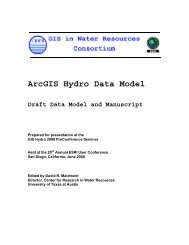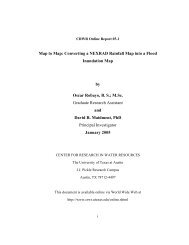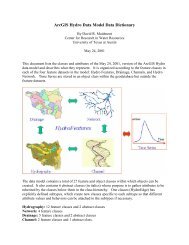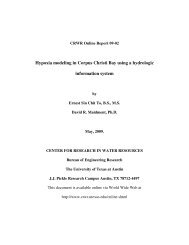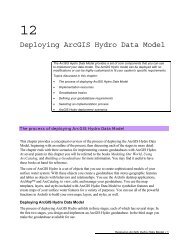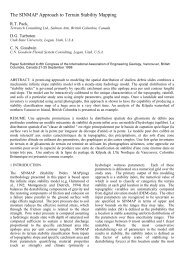View the Whole Report - Center for Research in Water Resources ...
View the Whole Report - Center for Research in Water Resources ...
View the Whole Report - Center for Research in Water Resources ...
Create successful ePaper yourself
Turn your PDF publications into a flip-book with our unique Google optimized e-Paper software.
The permeameter <strong>in</strong>itially was set up to run constant head tests with a Marriot<br />
tube. The first trial tests with silt fence fabric <strong>in</strong> lieu of a column of soil proved to dra<strong>in</strong><br />
too rapidly. The flow through <strong>the</strong> fabric was so turbulent and rapid that errors <strong>in</strong> tim<strong>in</strong>g<br />
<strong>the</strong> test were overwhelm<strong>in</strong>g. This situation was remedied by <strong>the</strong> fabrication of two<br />
sta<strong>in</strong>less steel plates that reduced diameter of <strong>the</strong> specimen from 15.2 cm to 2.54 cm. The<br />
column was modified by disconnect<strong>in</strong>g <strong>the</strong> Marriot tube and <strong>in</strong>stall<strong>in</strong>g a water supply<br />
controlled by a needle valve. These modifications allowed a f<strong>in</strong>e adjustment of <strong>the</strong> flow<br />
rates and facilitated ma<strong>in</strong>ta<strong>in</strong><strong>in</strong>g a constant head dur<strong>in</strong>g <strong>the</strong> tests. The modified soil<br />
permeameter with filter fabric specimen <strong>in</strong>stalled is illustrated <strong>in</strong> Figure 5.8.<br />
Inlet Valve<br />
Head<br />
Fabric Specimen<br />
Figure 5.8 Modified Soil Permeameter<br />
Dur<strong>in</strong>g a test <strong>the</strong> valve was adjusted until a steady state flow rate was achieved at<br />
<strong>the</strong> specified head. A conta<strong>in</strong>er of known volume was placed beneath <strong>the</strong> discharge from<br />
<strong>the</strong> column and <strong>the</strong> time required to fill <strong>the</strong> conta<strong>in</strong>er was recorded. Effects of entra<strong>in</strong>ed<br />
air on flow through a geotextile were determ<strong>in</strong>ed by us<strong>in</strong>g two sets of tests. In one test,<br />
<strong>the</strong> air was removed from <strong>the</strong> fabrics by apply<strong>in</strong>g a vacuum be<strong>for</strong>e each change <strong>in</strong> head.<br />
<strong>Water</strong> was drawn through <strong>the</strong> fabric prior to <strong>the</strong> test with a hose connected to a vacuum<br />
flask to remove any trapped air from <strong>the</strong> fabric. In <strong>the</strong> o<strong>the</strong>r test <strong>the</strong> samples were not<br />
vacuumed.<br />
49




